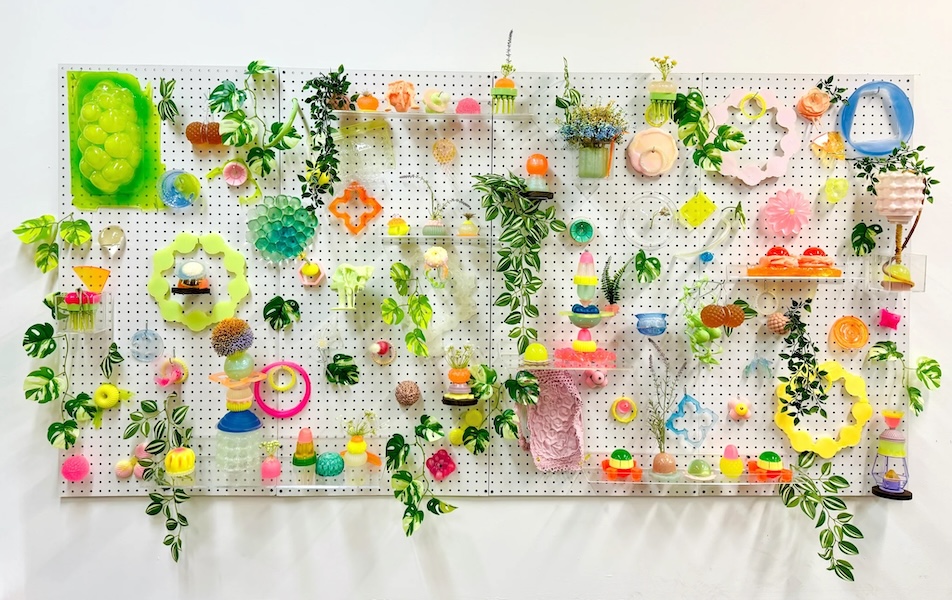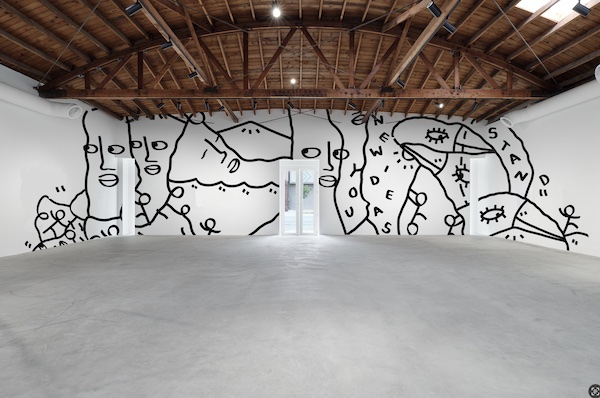The recently opened “Calder and Abstraction” show at the Los Angeles County Museum of Contemporary Art (LACMA) is a satisfying on many levels. The meticulously curated selection, mainly culled from the Calder Foundation’s archives by LACMA Senior Curator Stephanie Barron, edits Alexander Calder’s work into a stridently gutsy career of peacefully kinetic sculpture and painting. The viewer will find no references to Cirque Calder (the artist’s signature work from the 1920s) in “Calder and Abstraction,” nor will visitors be able to see any of Calder’s easily digestible caricatures. As I wander through the exhibit with Barron, she reveals the agenda.
“The goal was to do abstraction,” Barron tells me. “Calder is known for the circus and caricatures, and I wanted to try to position him back as an Avant-Garde artist. I think one of the problems with Calder is that we know all of the public sculpture, and we kind of don’t even see him anymore as an important artist, yet if you go back and look at these early works, they are breathtaking in terms of their inventiveness, and [how they] pushed the envelope of what sculpture could do.”

Berluti fall/winter 2017.
Courtesy of Berluti.
Barron’s point is that Calder is one of those canon artists, like Giacometti or Nevelson or Henry Moore, that sometimes needs a reboot of public opinion. They were considered great artists in their time, and don’t really need a whole lot more in terms of accolades and historical acknowledgement, but sometimes we forget to slow down and look at their work, because of that ubiquity. To help facilitate this reconsideration of Calder’s work – surprisingly the first time the artist has had a solo museum exhibition in Southern California – the museum enlisted legendary architect and Calder admirer Frank Gehry to build out a curvesome exhibition space, which offers respect to particular works or suites of work.
“Frank [Gehry] did an amazing job,” says Calder Foundation President Alexander “Sandy” Rower. “The biggest Calder show that’s ever been done was in Torino, Italy in 1983. Renzo Piano designed that show in this airport hangar-sized parabolic building. But this really represents the energy of each one of the objects.”

Moschino women’s pre-fall 2017 & men’s fall/winter 2017.
Courtesy of Moschino.
As you approach the exhibition, Gehry built two walls to curve together, creating an entranceway that gives the show a secretive feeling, as if you’re peeking into Calderworld. An intermediate maquette of the public sculpture “Trois Pics” (1967) – the finished 40-foot tall work is in the train station of Grenoble, France – greets you like the guardian of the show on one side, while “Little Face,” a Calder’s mobile floats above the other side, guiding the viewer towards the entrance like a beckoning finger, or a welcoming chandelier.
“The resulting whole of these two together gives you a sensation of what the show is about,” says Rower. “Together, they welcome you. You feel something just before you run this gauntlet of this magnificent progression.”

Hermès’ fall/winter 2017-18
Photo by by Jean-François José
The works in the show range from a suite of early experimental sculptures from the 1930s, to Calder’s sculptural paintings, mobiles, and standalones of the 1940s and 1950s, and on through to his heavier sculptures from the late-sixties and early-seventies. “Most exhibitions [of Calder’s work] don’t have movement,” says Barron. “We have air vents for the floors to help things move. I wanted people to slow down and look at these things very carefully, which is why there aren’t more than 50 works. It’s enough to cover the range from the early-thirties to the mid-seventies. I think people are just going to be blown away by the way he challenges the relationship between what’s a painting, what’s a sculpture, and how movement becomes almost a medium.”
As we enter through the towering walls, the early works from the 1930s that open the exhibition visibly excite Rower. He explains that “Croisiére,” from 1931, has a tension that if you touch one part of the sculptures, the other part quivers. “The two wooden balls at the top – the weight of them is pushing down and the molecules of the metal are under pressure right now, so it’s in a state of fine balance,” says Rower. Another early work is described as having complete interactivity, allowing the viewer to intervene with the sculpture’s kineticism, leaving the final configuration of the sculpture up to the viewer. Rower then launches into an anecdote about how Albert Einstein was transfixed by one of Calder’s sculptures, waiting several hours to see the movement cycle that Calder had given it.

Courtesy of Patricia Low Contemporary
“Seeing how they balance with engineering is pretty amazing,” adds Barron. “He was an engineer, but it’s all lo-tech: no welding, just crimping and twisting.” It’s not that sculptors don’t still work in this way (in fact, Rower cites contemporary artist Haroon Mirza as an example of a sculptor whose work often seems to hang in the balance) but the gestures made by Calder seem so genuine and modest as to be available to everyone. Anyone looking at a Calder mobile can marvel at the work’s kinetic energy, it’s balancing act, it’s slender beauty.
LACMA’s relationship with Calder dates back to the 1960s, when the museum was moving to its current location on Wilshire Boulevard. The museum commissioned Calder to make a work for its fountain, a piece that he called “Three Quintains (Hello Girls).” After the walkthrough, I headed out to the fountain and meditated by the work for a while as water spurted onto its plates, pushing them into a slow spin. The story goes that when Calder was creating the work, he would pass by it, offer a wave to the sculptures, and greet them: “Hello, girls.” As I stand around the edges of the fountain, Calder’s girls turn in the wind. Tranquility.

Courtesy of BFA and Creative Time.
No doubt Calder had the humor and whimsy to give his sculptures animistic qualities, but “Calder and Abstraction” is quite a serious look at the artist’s career, giving a sober look at the avant-garde nature of the work, allowing a full understanding of the mixture of vitality and serenity in Calder’s oeuvre. “Calder and Abstraction” is a show that deserves to be not only seen, but seen slowly.
“Calder and Abstraction” is on view at Los Angeles County Museum of Art until July 27, 2014.









